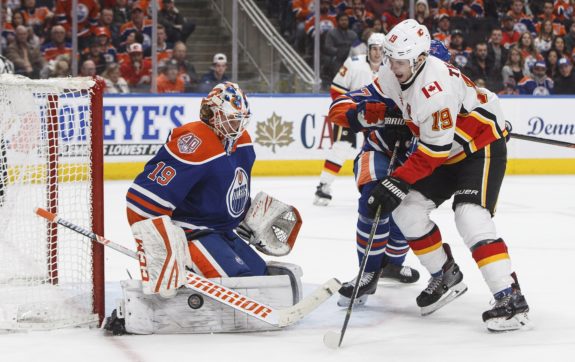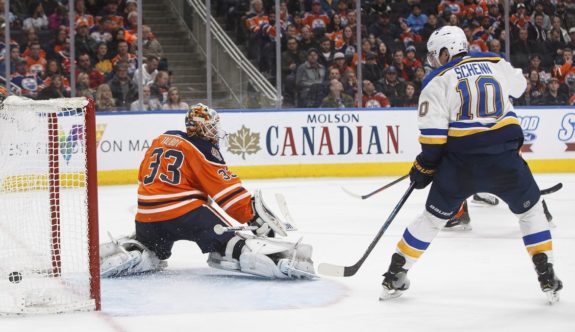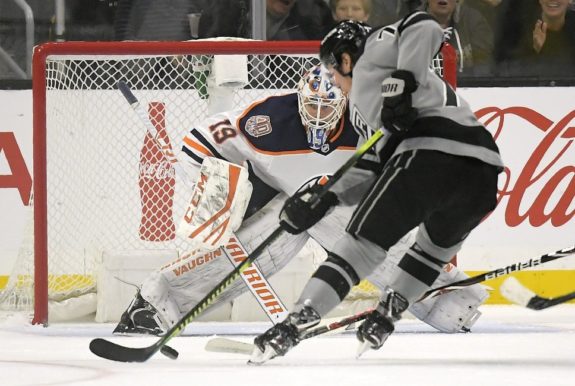With the focus on so many other aspects of the Edmonton Oilers’ roster this season, and with fans clamoring for a GM change after getting a coaching change, the impact of goaltending has been somewhat overlooked.
Take the Oilers’ significant run of success, going 7-2-1 from when Ken Hitchcock took over as head coach on Nov. 20 until Oscar Klefbom’s last full game in the lineup on Dec. 9. During those 10 games, Oilers goaltenders posted seven quality starts, well above the league average this season.

On the contrary, during their six game losing streak from Dec. 16-31, their goalies posted zero quality starts.
What Is a Quality Start in the NHL?
Quality starts are a statistic first counted by Rob Vollman in 2009. In his words, the idea is “blatantly lifted from baseball.” Simply put, the statistic is designed to count whether a goalie has given his team a chance to win. A quality start is counted when the starting goalie provides league average or better goaltending with a save percentage of .917 or higher, or allows two or less goals with at least an .885 save percentage.
According to Hockey-Reference, the average NHL regular posts a quality start 53.4 percent of the time, and the league’s best goalies are above 60 percent. From the same source, teams have won 77.7 percent of games in which their goalie has a quality start.
This season, with goal scoring up league-wide, both numbers have dropped somewhat, with 50.3 percent of starts counted as quality starts, and 74.8 percent of quality starts resulting in wins.
Cam Talbot and Quality Starts
Cam Talbot has been an average to above-average goaltender at various points of his career. Filling in for Henrik Lundqvist with the New York Rangers for two seasons, an excellent 62.3 percent of his starts were quality starts, prompting many teams, including the Oilers, to look to him as a top option to become their starting goalie for the 2015-16 season.
As the Oilers’ clear number one option, Talbot struggled with consistency for much of his first three seasons with the Oilers. He did, however, live up to expectations during the 2016-17 season with a quality start percentage of 58.9, earning himself a fourth-place finish in Vezina Trophy voting, and leading the team through two rounds in the playoffs.
This season, however, has been a major disappointment. In 25 starts, he has recorded just eight quality starts.

The Oilers and Talbot’s Quality Starts
Interestingly, the Oilers have been very good in Talbot’s eight quality starts, winning seven of those games. However, what happened in his non-quality starts truly stands out. In Talbot’s 17 other starts, the team has only won two games, barely half of the league-average of 21.1 percent this season for wins in non-quality starts.
Related – 3 Oilers That Need to Step Up
The Oilers have not allowed Talbot to overcome bad performances by outscoring their, or his, mistakes. In his 18 starts between Oct. 16 and Jan. 8, the Oilers did not win any of the 11 games in which he did not post a quality start. For nearly two months, he entered the net knowing the team result was resting almost entirely on his play.
The Oilers and Koskinen’s Quality Starts
The surprising flip side of this story is viewed in Mikko Koskinen’s starts. One might expect that a team’s performance is relatively stable regardless of which goaltender is playing. I certainly would have guessed that a team would respond to good or bad goaltending equally, no matter who is in net. In the long run, perhaps that is true, and may be an interesting topic to pursue another time.
Koskinen has posted quality starts 11 times this season, and in those games the Oilers have again been excellent, winning 10. Combined with Talbot’s numbers, the Oilers are winning 89.5 percent of games in which they receive a quality start, which compares favourably to the league average noted earlier.

However, it is in Koskinen’s 13 non-quality starts that the team’s performance differs dramatically. The Oilers have won four of those games, or 30.8 percent, well ahead of league average and nearly triple their success rate for Talbot’s non-quality starts.
The timing of those wins may be even more crucial. Three of Koskinen’s first five wins came in non-quality starts. Early in the season, while Talbot’s confidence was waning, the Oilers’ play provided Koskinen breathing room to make mistakes in games without losing.

I imagine this can’t be ignored when considering the direction the season has gone for both goalies, with Koskinen clearly serving as the preferred starting goalie under Hitchcock, starting 18 games to Talbot’s 11 in the last two months.
Goaltending and the Oilers’ Playoff Chase
Hitchcock’s role as head coach, particularly given that his contract only guarantees him this season, is to get this Oilers team into the playoffs. From that perspective it makes sense to ice whatever lineup gives the team the best chance to win every night. More often than not, Koskinen has served as the starting goalie.
While Koskinen went through a short stretch in which he was almost unbeatable, the history of both Oilers goalies suggest that, if the team is to go on any significant run, Talbot will need to recapture the elite form he maintained through the entire 2016-17 season. Most Oilers fans and pundits alike now believe that is unlikely, but I believe Hitchcock has a similar sense. Despite Talbot’s continued struggles, Hitchcock has given him somewhat regular starts in the hopes that he will rediscover his game.